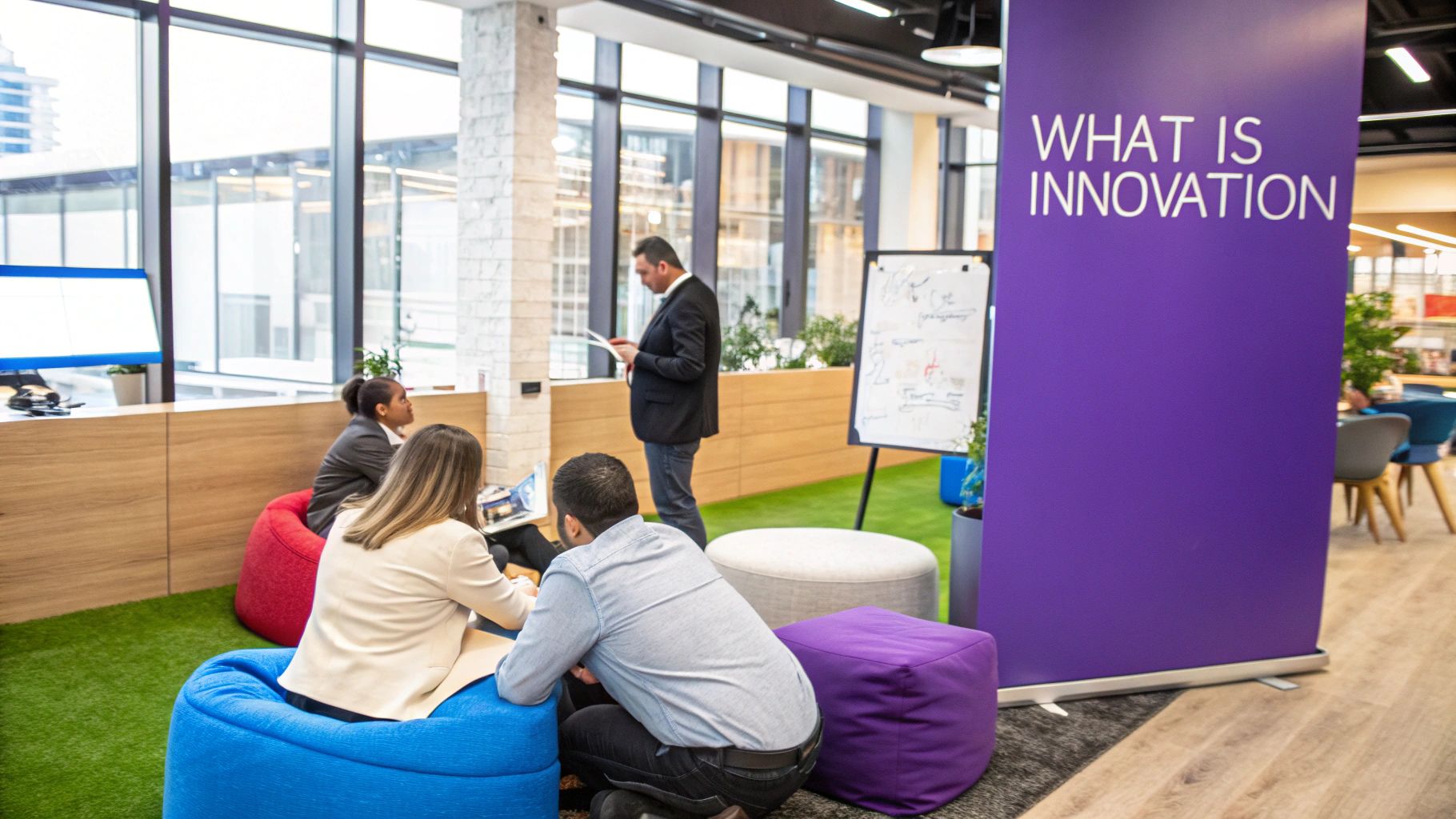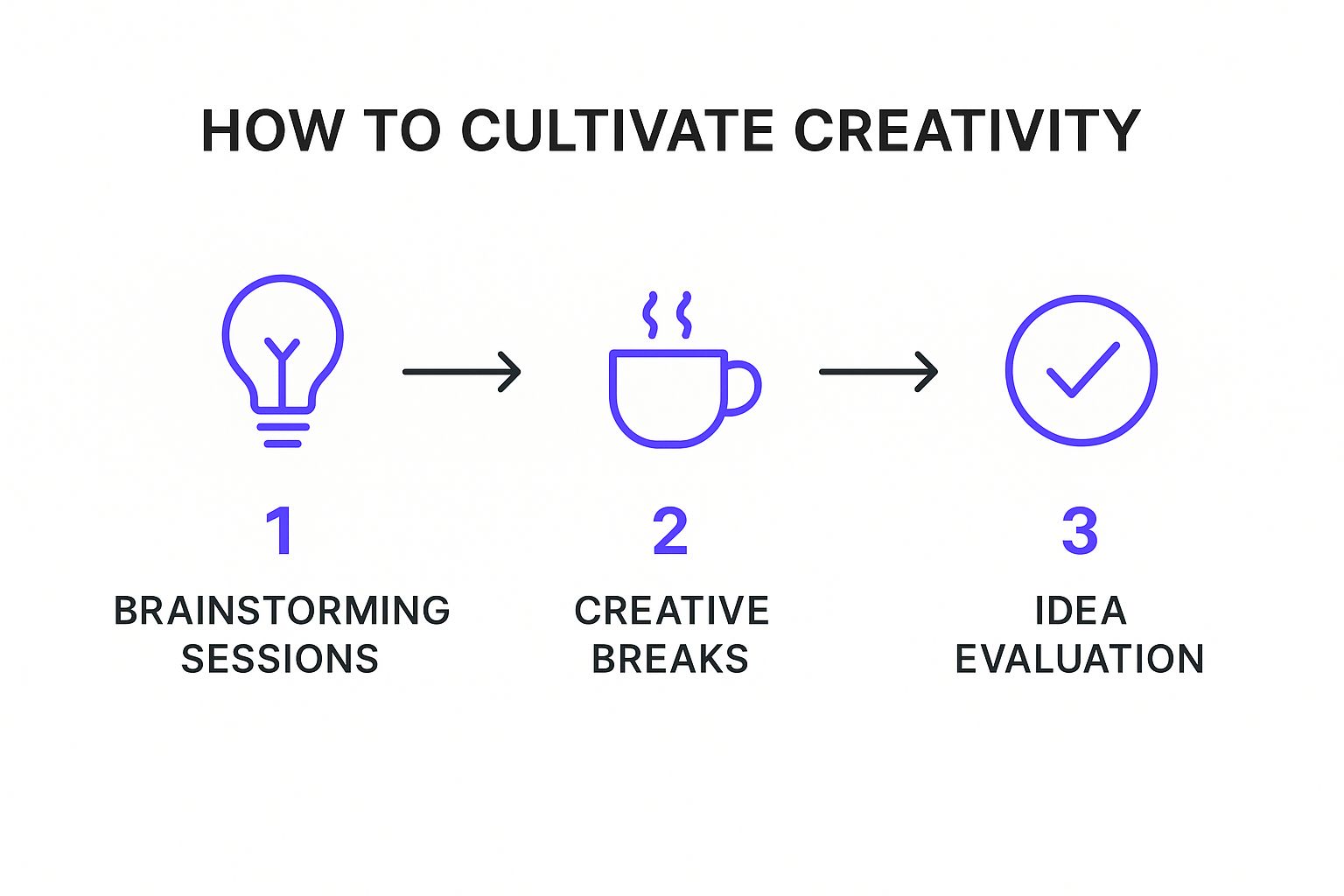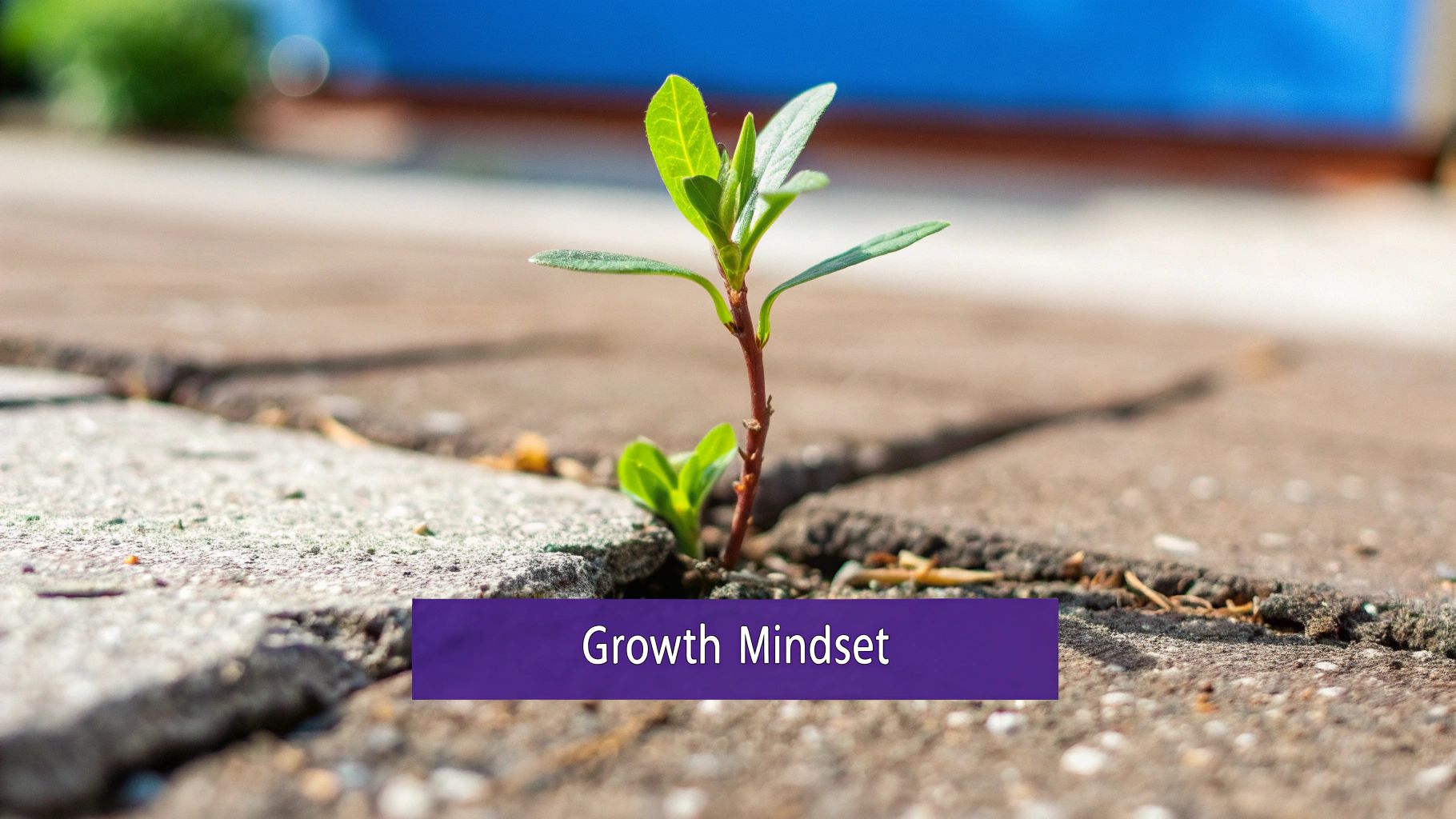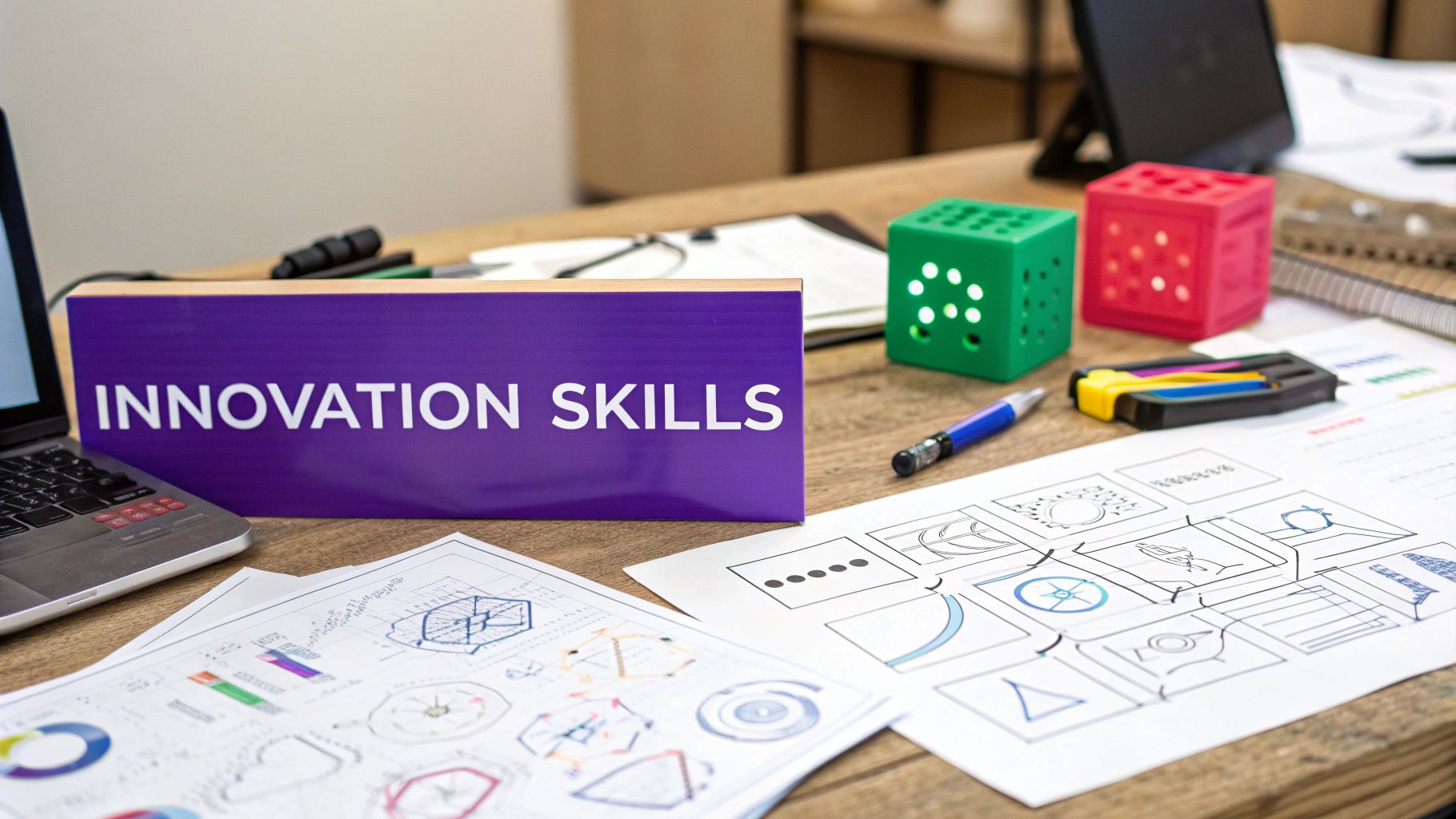If you want to get better at innovation, you have to start with the basics. It's less about fancy software and more about rewiring how you think. The real magic happens when you build a few core mental habits: cultivating curiosity, questioning the status quo, and embracing failure as a chance to learn. It all begins with a simple shift in how you see the world around you.
Building the Foundation for Innovation

Before you jump into specific brainstorming techniques or collaboration tools, you need to lay the right groundwork in your own mind. Innovation isn't some rare gift—it's a skill you can build through practice. The starting block for all of this is adopting a growth mindset, which means seeing challenges as opportunities to grow, not as dead ends.
This mindset is the soil where all other innovation skills grow. It's what separates the person who says, "This will never work," from the one who asks, "How could this work?" That one small change in language opens up a world of possibilities.
Cultivate Relentless Curiosity
The most innovative people I've worked with are incredibly curious. They're always asking "Why?" and "What if?" to get to the heart of how things work. This isn't about pondering life's great mysteries; it's about being curious in everyday work situations.
For example, when faced with a clunky internal process, a curious mind doesn't just sigh and accept it. They start asking questions:
- Why do we even do it this way?
- What was the original problem this process was designed to solve?
- What would happen if we just stopped doing it, or tried something completely different?
This constant questioning of "the way things are" is what sparks small improvements that often snowball into major breakthroughs. It’s critical to understand that innovation is a process of continuous inquiry, not a single lightbulb moment.
Learn to Reframe Problems
How you define a problem dictates the kind of solutions you'll come up with. Truly innovative people have a knack for looking at a challenge from different angles, which helps them spot opportunities others miss.
The most impactful innovators don't just solve existing problems; they redefine them. By changing the question, you can radically change the scope of possible answers, turning a minor issue into a major opportunity.
Think about a team worried about low user engagement on their app. The obvious path is to brainstorm new features to add. But an innovative reframing of the problem might lead to questions like, "What core human need are we failing to meet?" or "How could our app become absolutely essential for one specific daily habit?" This shifts the focus from just adding more stuff to creating real, tangible value.
The skills behind this way of thinking—analytical ability, resilience, and creative problem-solving—are more important than ever. The World Economic Forum's Future of Jobs Report 2025 found that analytical thinking is still the number one skill employers are looking for, with over 70% of companies calling it essential. This just goes to show that improving your innovation skills is about building a well-rounded mental toolkit for the modern workplace.
Actionable Exercises To Boost Creative Thinking
Telling someone to "think outside the box" is probably the least helpful advice you can give. Real innovation isn’t about vague platitudes; it’s a skill. And like any other skill, you can build it with consistent, focused practice.
The key is moving from abstract ideas to concrete exercises that push you and your team to think differently. These techniques give your creative process a much-needed framework, helping you generate not just more ideas, but better ones.

This simple flow shows that creativity isn't a single "aha!" moment. It's a cycle of coming up with ideas, letting them marinate, and then looking at them with a critical eye.
Use SCAMPER To Remix Your Ideas
One of my go-to methods for breaking through a creative block is SCAMPER. It’s a fantastic checklist that forces you to look at an existing product, service, or problem from seven different angles.
Instead of trying to invent something from scratch, you use what's already there as a springboard.
- Substitute: What part of this could we swap out? Think about swapping plastic packaging for a mushroom-based, biodegradable alternative.
- Combine: Can we merge two unrelated ideas? This is how you get things like a phone case that doubles as a wallet.
- Adapt: How could we adjust this for a totally different context? For example, adapting a consumer drone delivery system to rush medical supplies to remote areas.
- Modify: What if we changed its size, shape, or features? This could be as simple as creating a mini, travel-sized version of a popular kitchen gadget.
- Put to another use: Could another industry use this? Memory foam was developed for NASA but found a new life in mattresses.
- Eliminate: What could we remove to make it simpler or more elegant? Think of a software program that strips away 90% of the features to create a minimalist, focused tool.
- Reverse: What happens if we flip the process or reorder the steps? A great example is a subscription box where customers pay after trying the products, not before.
Going through the SCAMPER list methodically pulls your brain out of its usual ruts and opens up genuinely new pathways.
Dig Deeper With The Five Whys
Sometimes, the most innovative thing you can do isn't to create something new, but to truly understand an old problem. That's where the Five Whys technique comes in. It’s a beautifully simple method developed at Toyota for getting to the root of an issue.
You start with a problem and just keep asking "Why?" until you've peeled back all the layers of symptoms.
The point of the Five Whys isn't just to find a quick fix. It’s about exposing the foundational breakdown so you can solve the right problem. This is where truly impactful innovation happens.
Imagine a team keeps missing deadlines.
- Why? Because key tasks are running late.
- Why? Because a certain report is always delayed.
- Why? Because the person responsible is overloaded.
- Why? Because they're doing work for two different projects.
- Why? Because there’s no clear project ownership assigned at the start.
Boom. The issue isn't time management; it's a structural problem. Fixing that is a much more valuable use of your energy.
More Techniques to Explore
SCAMPER and the Five Whys are just the beginning. Plenty of other structured exercises can help your team break out of conventional thinking patterns. Here's a quick look at a few popular ones.
Creative Thinking Techniques Explained
| Technique | Primary Goal | Example Application |
|---|---|---|
| Mind Mapping | Visually organize and connect ideas around a central concept. | Starting with "New Mobile App" and branching out to features, user types, and revenue models. |
| Reverse Brainstorming | Identify potential problems or failures instead of solutions. | Instead of "How to increase user engagement?" ask "How could we make users hate our app?" |
| Six Thinking Hats | Look at a decision from six distinct perspectives (facts, feelings, etc.). | Evaluating a new product launch by systematically wearing each "hat" to ensure all angles are covered. |
Having a few of these in your back pocket can completely change the dynamic of a stale brainstorming session.
If you want to build a bigger library of exercises, this is a great resource for more creative thinking exercises to try with your team. And don't forget that modern tech can be a powerful partner in this process—it's worth looking into enhancing creativity with free AI tools to see how they can act as a creative assistant.
Using Analytical Skills to Find Breakthrough Ideas

A brilliant idea is only half the battle. I've seen countless creative concepts fall flat because they weren't grounded in reality. The most successful innovations happen when that creative spark is guided by sharp, insightful analysis.
This is how you connect a cool concept to a real-world problem. It’s about building the muscle for making evidence-based decisions, which is the secret to truly improving your innovation skills. You don't need to be a data scientist to do it, either. It’s all about spotting real opportunities, checking your assumptions, and being able to pitch your ideas with confidence because you have the data to back them up.
Spot Opportunities in Data
Often, the best ideas come from noticing what everyone else is missing. The first step is learning how to sift through everyday information to find those hidden gems—those unmet needs or frustrating friction points that are just waiting for a solution.
It's simpler than it sounds.
- Customer Feedback: Dive into your support tickets, read online reviews, and scan social media comments. Are people constantly complaining about the same thing? That’s not a nuisance; it’s a bright, flashing sign pointing you toward an opportunity.
- Sales Data: Look at who is buying your products and how they're using them. Sometimes, a group of customers will use a product for something you never intended. That could be an entirely new market you've accidentally discovered.
- Website Analytics: Where are people giving up? If a specific page has a high exit rate, you’ve likely found a major point of frustration in your user experience—something ripe for a fix.
The whole point is to shift from "I think this is a good idea" to "I know this is a problem because the data shows it." This skill is only becoming more important. A 2024 analysis actually forecasts that analytical thinking will be a top required skill by 2025, thanks to the growth of automation. As machines handle the repetitive stuff, our value lies in interpreting data and thinking critically. You can read more about these future workforce predictions on totara.com.
Validate Ideas With Small Experiments
So you've found a promising idea. The natural impulse is to jump right in and build the whole thing. Resist it. Instead, think like a scientist and design small, cheap experiments to test your most important assumptions.
Treat your initial idea as a hypothesis, not a fact. The goal of an experiment isn't to prove you're right; it's to learn as much as you can, as quickly and inexpensively as possible. This approach is your best defense against wasting time and money.
Let’s say you want to add a new feature to your app. Instead of spending months developing it, you could build a simple landing page that describes the feature and asks people to sign up for early access. This is a classic "smoke test." It measures genuine interest before you've written a single line of code.
By defining success upfront (e.g., "we need 100 sign-ups to proceed"), you can make an objective call. This disciplined, methodical testing is a huge part of improving your innovation skills. When you're working with a team, checking out some online brainstorming tools can be a great way to keep all these experimental ideas organized and track your progress.
Fostering Innovation Through Smart Collaboration
Let's be honest, breakthrough ideas rarely spring from one person working alone in a dark room. The really game-changing stuff? It's almost always sparked when different minds, with different experiences, come together. If you're serious about getting better at innovation, learning how to collaborate well is every bit as critical as honing your own creative instincts.
True collaboration isn't just about getting everyone in a room to talk. It’s about building a space where ideas can be shared, pulled apart, and put back together stronger than before. This requires moving away from aimless meetings and toward a more deliberate process that lets your team's innovative spirit shine, time and time again.
Create a Foundation of Psychological Safety
If there’s one secret ingredient to all of this, it’s psychological safety. It’s that shared feeling in a team that you can speak up—with a new idea, a question, a concern, or even a mistake—without fear of being shut down or embarrassed.
Without it, you get silence. People will keep their "wild" ideas to themselves because they don't want to look silly. They won't question the status quo because they don't want to be labeled as difficult. Time and again, research proves that teams with high psychological safety simply perform better because everyone is willing to take the small, interpersonal risks that are the bedrock of learning and innovation.
An environment where failure is treated as a data point, not a personal failing, is essential. When people feel safe to experiment and be wrong, they also feel safe to be brilliant.
A surprisingly effective way to start is for leaders to get comfortable admitting their own mistakes and uncertainties. It models the right kind of vulnerability and signals to everyone else that it's okay to be human. That's where real collaboration begins.
Run Brainstorms That Actually Work
So many brainstorming sessions are a waste of time. The loudest person in the room steers the conversation, good ideas get shot down before they have a chance to breathe, and you walk away with a few predictable, safe concepts. A good brainstorm needs structure.
I’m a big fan of "silent brainstorming." Give everyone a stack of sticky notes and a clear prompt, then set a timer for 10-15 minutes of quiet, individual idea generation. This technique, also known as brainwriting, levels the playing field. It helps prevent groupthink and gives quieter, more introverted team members a chance to get their best ideas on the table before the discussion even starts. If you want to dive deeper, our guide on how to run a brainstorm session has some great step-by-step advice.
Bring Together Cross-Functional Teams
Tackling a tough problem means you have to see it from all sides. That's why cross-functional teams are such a game-changer. When you pull people from different parts of the business—think engineering, marketing, sales, and customer support—you get a much richer, more complete picture of the challenge at hand.
Suddenly, you have a room where:
- An engineer sees the technical path forward.
- A marketer knows exactly how to frame the solution for customers.
- A sales rep can anticipate the objections and questions they'll get.
- A support specialist brings in the raw, real-world pain points your users are facing today.
This mix of perspectives shatters the tunnel vision that kills so many good ideas inside siloed departments. It creates unexpected connections and makes sure the solution you land on isn't just clever, but also something people actually want and can use.
Adopting Modern Tools and Continuous Learning

The tools you use and your attitude toward learning are massive levers for innovation. Think about it: you can have the best ideas in the world, but if you’re trying to build a skyscraper with a hammer and nails, you're going to fall behind. Sticking with outdated methods is a recipe for irrelevance.
Building your innovation muscle isn't a one-and-done workshop. It’s a continuous journey. You have to stay curious and keep your skills sharp, but that doesn't mean you need to sign up for another degree. Modern learning is far more flexible.
Embrace Agile Learning and Micro-Credentials
Things change fast. So, you need to learn fast. This is where micro-credentials have become so valuable. They’re short, focused courses that get you up to speed on a specific skill or new technology without derailing your work for months.
Coursera's 2025 Global Skills Report, which pulled data from over 170 million learners, highlights this perfectly. It found that more than 90% of both students and employers believe micro-credentials are key for developing the innovation skills needed right now. This isn't just a hunch; it's a global shift toward practical, on-demand learning, especially as AI continues to reshape industries. You can dive deeper into how different countries are adapting in the full report on Coursera.
The bottom line? Bite-sized, continuous learning isn't just a nice perk anymore. It’s a fundamental part of staying competitive and genuinely innovative in your field.
Leverage the Right Digital Tools
A great mindset is the foundation, but the right tools are the accelerator. They can clear the clutter from your mind, organize sprawling ideas, and make collaborating with your team feel effortless—a lifesaver for remote teams. For more on that, you can check out our guide on remote innovation strategies.
Here are a few types of tools I've seen make a real difference:
- Digital Whiteboards: Forget huddling around a physical board. Tools like Miro or Mural let you brainstorm, map out ideas, and connect the dots with your team from anywhere. They’re a game-changer for visual thinking.
- Idea Management Software: An idea is useless if it gets lost in an email chain. Platforms like Airtable or a more specialized tool like Brightidea create a central hub to capture, track, and vet ideas from everyone.
- Prototyping Tools: Before you write a single line of code, tools like Figma or InVision let you build clickable mockups. It’s the fastest way to see what works and get real feedback.
It's not just about using tools, though. The real magic happens when you explore innovative strategies for AI workflow automation. By letting automation handle the repetitive, mind-numbing tasks, you free up your brain for the kind of deep, creative work that actually leads to breakthroughs. This isn't about replacing people; it's about augmenting your team’s creative potential.
Common Questions About Improving Innovation Skills
It's completely normal to have questions when you start trying to build your innovation muscles. The path isn't always a straight line, and it’s easy to second-guess yourself along the way. Let's tackle some of the most common concerns I hear with straightforward, practical answers.
This isn't about high-level theory. It's about giving you real guidance you can put to work today, whether you're a designer in a creative studio or an accountant in a structured firm. Think of this as a quick chat to help clear up your next steps.
Can Innovation Skills Be Learned, or Are You Born With Them?
This is probably the biggest myth holding people back. We've all been sold the story of the lone genius having a sudden "eureka!" moment, but that's mostly fiction. The truth is, innovation is a skill, just like playing the guitar or learning to code.
It is absolutely something you can learn, practice, and get better at over time. Anyone can become more innovative by adopting a growth mindset, intentionally using creative thinking tools, and, most importantly, learning from the inevitable missteps. It’s a journey of consistent practice, not a genetic lottery.
Innovation is a muscle, not a magic trick. The more you exercise it through structured practice and real-world application, the stronger and more reliable it becomes.
What Is the Single Most Important Habit for an Innovator?
If I had to boil it down to just one thing, it would be deep curiosity. This is more than just a passing interest in new topics. It’s the active, consistent habit of asking two deceptively simple questions about everything: “Why?” and “What if?”
This simple practice forces you to dig deeper than the surface of any problem or process.
- “Why?” helps you peel back the layers to find the root causes and unstated assumptions everyone else just accepts.
- “What if?” cracks open the door to imagining entirely new possibilities and alternative ways of doing things.
Make this your default way of thinking, and you'll start spotting opportunities that were hidden in plain sight. This habit is the engine that powers every other innovation skill, from understanding customers to prototyping new ideas.
How Can I Practice Innovation if My Job Is Routine?
I hear this a lot. Many people feel trapped by routine, thinking there’s no room to innovate in a process-driven role. That couldn't be further from the truth. Innovation isn't always about creating a world-changing new product; often, it’s about making things better, one small, smart improvement at a time.
Start by looking for small-scale opportunities right in your daily work.
- Fix a clunky process: Is there a step in your workflow that always feels awkward or slow? Sketch it out and propose a simpler alternative.
- Automate a small task: Could a simple software rule or script take over that repetitive data entry you do every week?
- Reorganize information: Suggest a better way to structure the team’s shared drive so everyone can find what they need in seconds, not minutes.
These "micro-innovations" build momentum and demonstrate your ability to think differently. You could also kick off a small side project outside of your main duties to flex your creative muscles in a low-stakes setting. The key is to start seeing your daily work not as a fixed set of instructions, but as a series of puzzles waiting for a better solution.
Ready to move from questions to structured action? Bulby is a fantastic brainstorming tool designed specifically for remote teams. It provides AI-powered guidance and uses research-backed exercises to run brainstorming sessions that actually get results. With Bulby, you can make sure every voice is heard, smash through creative blocks, and turn your team’s raw ideas into real-world solutions. Find out more and start your first session with Bulby.

